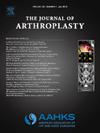Cemented Hemiarthroplasty Results in Substantial Cost Savings Over Uncemented Hemiarthroplasty for the Treatment of Femoral Neck Fractures in Patients Over 60 Years Old: A Markov Analysis
IF 3.8
2区 医学
Q1 ORTHOPEDICS
引用次数: 0
Abstract
Background
While there is growing scientific evidence supporting superior outcomes following cemented versus uncemented hip hemiarthroplasty (HHA) in elderly femoral neck fractures (FNFs), the relative cost-effectiveness of this in the United States is unknown. Thus, the purpose of this study was to compare the cost-effectiveness of cemented versus uncemented HHA for the treatment of FNFs in patients > 60 years old in the United States, accounting for postoperative outcomes including periprosthetic fractures.
Methods
A Markov model utilizing Monte Carlo microsimulation was developed to evaluate the outcomes and costs of patients at least 60 years of age (mean ± SD, 84 ± 8 years) undergoing cemented versus uncemented HHA for the treatment of FNFs. Health utility values, transition probabilities, and upfront costs were derived from the published literature. Outcome measures included average total costs associated with each treatment (including those from patients who sustained a periprosthetic fracture), quality-adjusted life years (QALYs), and the incremental cost-effectiveness ratio.
Results
Mean total costs resulting from cemented and uncemented HHA were $19,462 ± 3,581 and $21,997 ± 3,574, respectively, (upfront costs from the published literature were $18,267 for cemented HHA and $16,803 for uncemented HHA). Average QALYs resulting from cemented and uncemented HHA were 4.0 ± 0.7 and 3.1 ± 0.6. The resulting incremental cost-effectiveness ratio was -$2,688.9/QALY. Cemented HHA was found to be the most cost-effective treatment strategy in 89% of the patients in the Monte Carlo microsimulation model.
Conclusions
Despite documented higher upfront costs for cemented HHA, the averaged total costs over a 10-year time horizon were $2,534 less for cemented HHA than for uncemented HHA. In addition, cemented HHA resulted in an additional 0.9 QALYs relative to uncemented HHA. The findings of this US-based study replicate the financial and quality-of-life benefits of cemented HHA for elderly FNFs seen in other health systems.
在治疗 60 岁以上股骨颈骨折患者方面,与非骨水泥半关节成形术相比,骨水泥半关节成形术可节省大量成本:马尔科夫分析
背景:越来越多的科学证据表明,在治疗老年股骨颈骨折(FNFs)时,骨水泥与非骨水泥髋关节半置换术(HHA)的疗效更佳,但在美国,其相对成本效益尚不清楚。因此,本研究的目的是比较骨水泥与非骨水泥 HHA 治疗美国 60 岁以上股骨颈骨折患者的成本效益,并考虑包括假体周围骨折在内的术后结果:方法:利用蒙特卡洛微观模拟建立了一个马尔可夫模型,以评估至少 60 岁(平均值±标准差,84±8 岁)的患者接受骨水泥与非骨水泥 HHA 治疗 FNFs 的结果和成本。健康效用值、转变概率和前期成本均来自已发表的文献。结果测量包括与每种治疗方法相关的平均总成本(包括假体周围骨折患者的成本)、质量调整生命年(QALYs)和增量成本效益比(ICER):骨水泥和非骨水泥 HHA 的平均总成本分别为 19,462 美元± 3,581 美元和 21,997 美元± 3,574 美元(根据已发表文献,骨水泥 HHA 的前期成本为 18,267 美元,非骨水泥 HHA 的前期成本为 16,803 美元)。骨水泥和非骨水泥 HHA 的平均 QALY 分别为 4.0 ± 0.7 和 3.1 ± 0.6。由此得出的 ICER 为-2,688.9 美元/QALY。在蒙特卡洛微观模拟模型中,89%的患者认为骨水泥HHA是最具成本效益的治疗策略:尽管有记录显示骨水泥HHA的前期成本较高,但在10年的时间跨度内,骨水泥HHA的平均总成本比非骨水泥HHA低2,534美元。此外,与非粘结性 HHA 相比,粘结性 HHA 额外增加了 0.9 QALY。这项以美国为基地的研究结果复制了其他医疗系统中为老年 FNF 提供的骨水泥 HHA 在经济和生活质量方面的益处。
本文章由计算机程序翻译,如有差异,请以英文原文为准。
求助全文
约1分钟内获得全文
求助全文
来源期刊

Journal of Arthroplasty
医学-整形外科
CiteScore
7.00
自引率
20.00%
发文量
734
审稿时长
48 days
期刊介绍:
The Journal of Arthroplasty brings together the clinical and scientific foundations for joint replacement. This peer-reviewed journal publishes original research and manuscripts of the highest quality from all areas relating to joint replacement or the treatment of its complications, including those dealing with clinical series and experience, prosthetic design, biomechanics, biomaterials, metallurgy, biologic response to arthroplasty materials in vivo and in vitro.
 求助内容:
求助内容: 应助结果提醒方式:
应助结果提醒方式:


